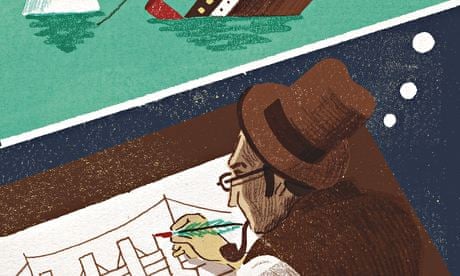
'Hindsight makes things look so utterly different that it's impossible, when taking a decision in the moment, even to begin to grasp how it'll strike you later on'

'Hindsight is even more transformative than you think.' Illustration: Daniel Haskett for the Guardian
Human history, as you're doubtless aware, is one long cavalcade of failure and catastrophe. But amid all those fiascos, there's one uniquely humiliating subcategory: the kind where it's impossible to imagine how anyone could have thought it a good idea in the first place. The foolishness involved can be relatively minor (such as "restoring" a painting of Jesus in your local church, so that he resembles a hairy monkey) or huge (such as launching a new healthcare system for a country of 310 million people with a website that crashes when a few thousand use it). But, with hindsight, the question is the same: what were they thinking?
One obvious conclusion to draw from this – and I'm not saying it's wrong – is that people are idiots. But a more interesting one is that hindsight is even more transformative than you think. It doesn't just make things look different; it makes them look so utterly different that it's impossible, when taking a decision in the moment, even to begin to grasp how it'll strike you later on.
Well, perhaps not impossible. Maybe actually quite easy – if we employed a technique that almost nobody uses, invented by the psychologist Gary Klein, and which Daniel Kahneman, his Nobel-winning colleague, describes as his favourite method for making better decisions. Klein calls it the "premortem", and it's embarrassingly simple: you imagine yourself in the future, after the project you're considering has ended in spectacular failure. "Unlike a typical critiquing session, in which project team members are asked what might go wrong, the premortem operates on the assumption that the 'patient' has died," Klein writes. In the fantasy world of the premortem, it's already over. You're screwed. Everything went as badly as you could have feared. Now: why?
Asking the question this way, Klein explains, has an almost magical effect. It removes the pressure from those who are worried about seeming disloyal by voicing concerns; indeed, it turns things into a competition to find ever more convincing reasons for failure. "It's a sneaky way to get people to do contrarian, devil's-advocate thinking without encountering resistance," as Klein once put it. Another advocate of "prospective hindsight", the academic Karl Weick, argues that it works because of a cognitive quirk: we find it easier to imagine the detailed causes of a single outcome than causes of multiple outcomes. (There's more on all this in Scaling Up Excellence, a new book by two Stanford professors.) And if you think it's all obvious‚ well, sure, but when did you last do it? "I mentioned it at Davos," Kahneman said a while back, and "the chairman of a large corporation said it was worth coming to Davos for". Klein cites research suggesting that using prospective hindsight can improve people's ability to predict the reasons for future outcomes by 30%.
Klein focuses on hypothetical failure, as opposed to success, because it is failure that people are so unwilling to confront. But prospective hindsight can be used to imagine things going right, too. That's the thinking behind the wise old advice to "picture yourself at your own funeral". In the best-case scenario, what would you want people to be saying in their eulogies – and are you living in such a way as to make that likely? Hindsight, we're told, is a wonderful thing. But hindsight in advance is even better.
oliver.burkeman@theguardian.com
Follow Oliver on Twitter.
Source of this article;